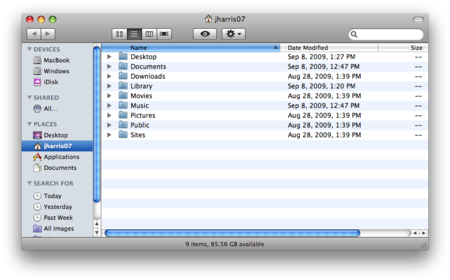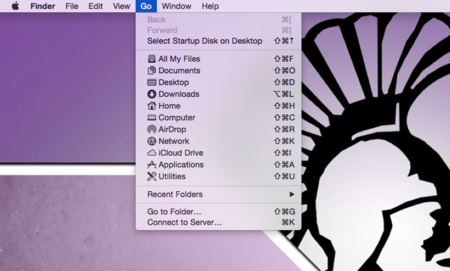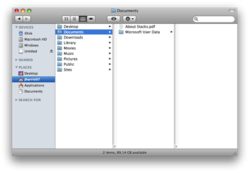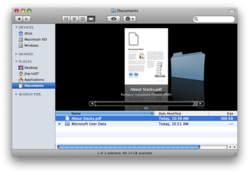Difference between revisions of "Where on your Mac laptop are your files"
| Line 10: | Line 10: | ||
*All MacBooks have an icon on the Desktop that provides access to the hard drive. The icon is labeled with the model of your MacBook and the year you received it (Fig 1). Double-click this icon to open it. | *All MacBooks have an icon on the Desktop that provides access to the hard drive. The icon is labeled with the model of your MacBook and the year you received it (Fig 1). Double-click this icon to open it. | ||
*When you open your hard drive, you will see a list of subfolders, including Applications, Library, System, and Users. Do not touch the first three folders. These store important operating system and application files. | *When you open your hard drive, you will see a list of subfolders, including Applications, Library, System, and Users. Do not touch the first three folders. These store important operating system and application files. | ||
| − | *Your Users folder includes your Home directory. It has an icon that looks like a house and it's labeled with your username. This will appear slightly different depending on the operating system you are using (Fig 2). | + | *Your Users folder includes your '''Home''' directory. It has an icon that looks like a house and it's labeled with your username. This will appear slightly different depending on the operating system you are using (Fig 2). |
==About the Home folder== | ==About the Home folder== | ||
Revision as of 14:24, 24 June 2015
About this article
This article defines the default file folder locations of all WSU-supported Mac laptops. It is intended for both students and employees who participate in the eWarrior Digital Life and Learning Program. It is important for everyone to know where their files are at all times, especially when preparing for a laptop exchange or re-image.
Where are your files?
You have full administrative rights to your laptop. That means you have the ability to save your files just about anywhere on your laptop's hard drive. You may have saved things, intentionally or unintentionally, to locations other than the ones we describe in this article. It's up to you to find and manage those folders and files. ITS configures every MacBook hard drive the same way:
- All MacBooks have an icon on the Desktop that provides access to the hard drive. The icon is labeled with the model of your MacBook and the year you received it (Fig 1). Double-click this icon to open it.
- When you open your hard drive, you will see a list of subfolders, including Applications, Library, System, and Users. Do not touch the first three folders. These store important operating system and application files.
- Your Users folder includes your Home directory. It has an icon that looks like a house and it's labeled with your username. This will appear slightly different depending on the operating system you are using (Fig 2).
About the Home folder
Your Home folder is a special folder on your hard drive set up just for you. This is where you should save any personal or school-related files on your laptop. To help you keep your files organized, WSU created some sub-folders in your Home folder (e.g., Documents, Music, Pictures). You can use these folders if you wish or you can create your own. You can also create sub-folders within these folders (e.g., a Courses folder inside your Documents folder). Build a folder structure that works for you. Open a Finder Window to show the contents that you want to back up. On your WSU Mac you will find all your important files in your Home Directory. The Home Icon looks like a little house and is named with your User Logon ID. Depending on the version of operating system you have, the Home folder my show in the left navigation. If not, open the Finder and select Go. From the drop down menu you can choose Home. Inside your Home Directory are the following folders:
- Documents-all of your files are likely there
- Downloads
- Pictures-all your pictures should be there
- Music-all your music (iTunes and more) should be there
- Sites-any web sites you created will be there
- Desktop-anything on your desktop is there
- Library
- Applications
- Public
The files you will want to backup are shown in BOLD in the list above. You will not need to backup anything else.
NOTE: You can position the two Finder Windows to be side by side for dragging, but only one Finder Window can be active or in-front at a time.
Managing your Mac with Finder
Your system and applications are located in file folders inside your hard drive icon (“Macintosh HD”). Do NOT move or delete these files. To correctly remove or uninstall an application, use the instructions provided for that application.
If you want an icon for an application on your desktop you can create an “Alias” for it by selecting it and using a Right-Mouse menu to select that option. The Alias icon can then be placed where you wish to put it.
All of your data files, including your music and picture files, are kept inside a special Home Directory which is identified by your user logon.
Finder and File organization
You can use your Finder to view/find the files that you have stored on your computer, on attached devices (such as portable hard drives or flash drives, and in network storage. The Home Directory is where your files are automatically stored.
Your Home Directory consists of eight folders that are referred to as the “root” folder for that “directory.” These root folders include Desktop, Documents, Library, Movies, Music, Pictures, Public, and Sites.
The Desktop folder includes all of the files on the desktop which you see when you start up your Mac and which appears to be underneath this Finder Window. When backing up your important files, you will need to make sure that you back up this “Desktop” folder. See more about backing up below.
The Documents folder is where Microsoft Office applications save your Word, Excel, and PowerPoint files by default. Your iTunes Music go into the Music folder and iPhoto pictures go into the Pictures folder. When you download something, it will automatically be placed inside your Downloads folder.
By clicking the drop down “Cog” button you will have clickable access to creating a New Folder, opening the file, Get Info, and other options for this file or this place in the directory.
Get Info is the used when you would like to modify important attributes of the file. This function can be used to change the name of the file, the file extension, the color label, the icon and security and sharing settings. At the top of every finder window you will find a red, yellow, and a green button. The red button closes the open window. The yellow button reduces the window to your dock. The green button enlarges the size of the window. Below the three buttons you will find a right and left navigation button.
The three buttons to the right of the navigation button control the way that you VIEW your files in the window. You can view them as icons, as a list, in columns of folders and contents, and in Cover Flow.
This View is good for seeing how documents are stored inside the hierarchy of folders on your computer.
It will show you what the actual document selected looks like. If you press your space bar, it will open that item into a full preview.
Creating a Directory or File Organization
Many students create new folders in their Home Directory or inside Documents or other folders to keep class files and personal files organized.
By using a rigid file organization structure you can more easily back-up data.
It will also make it easier to locate and use files for your senior portfolio project.
An example of such a file structure is shown here.






